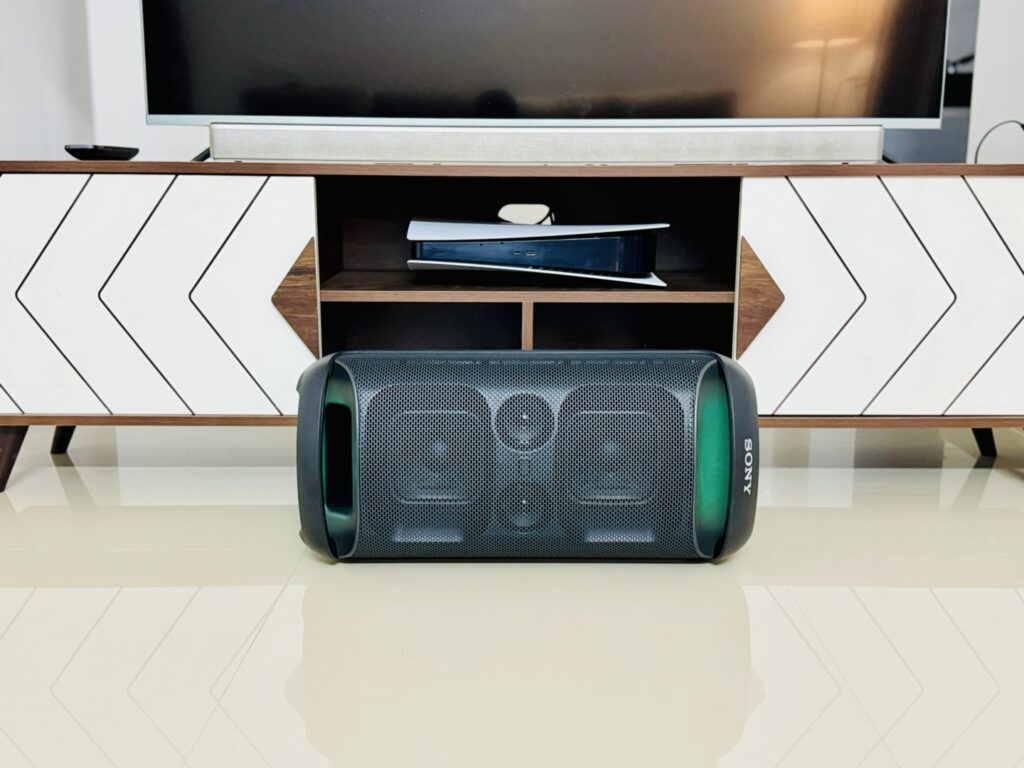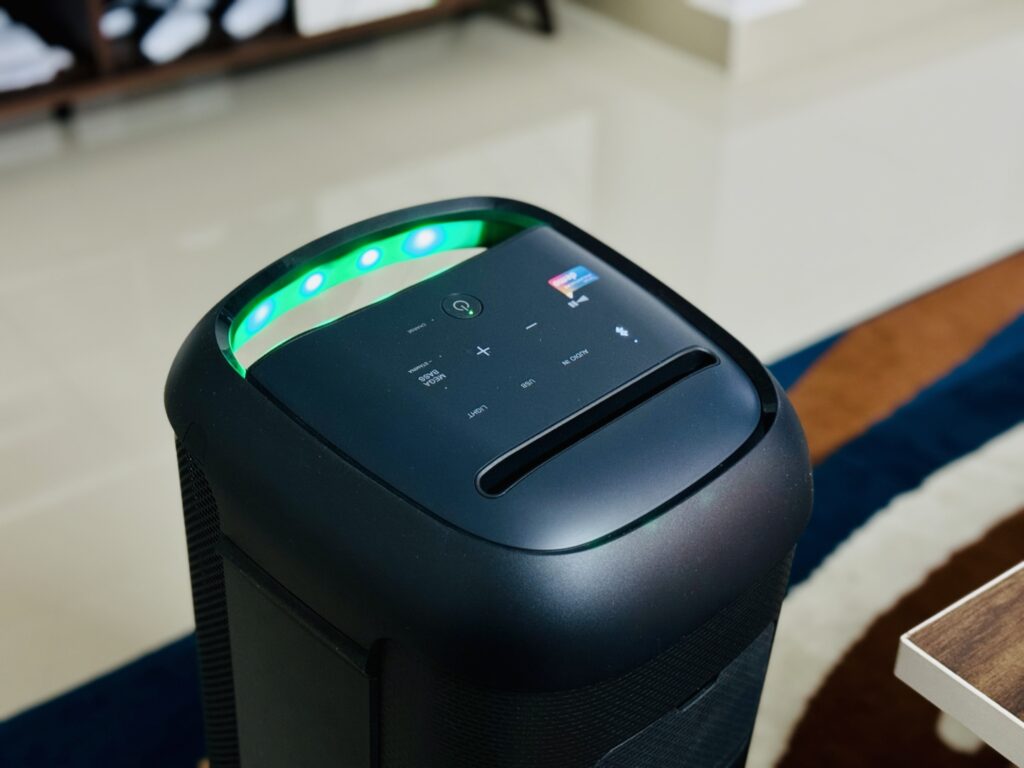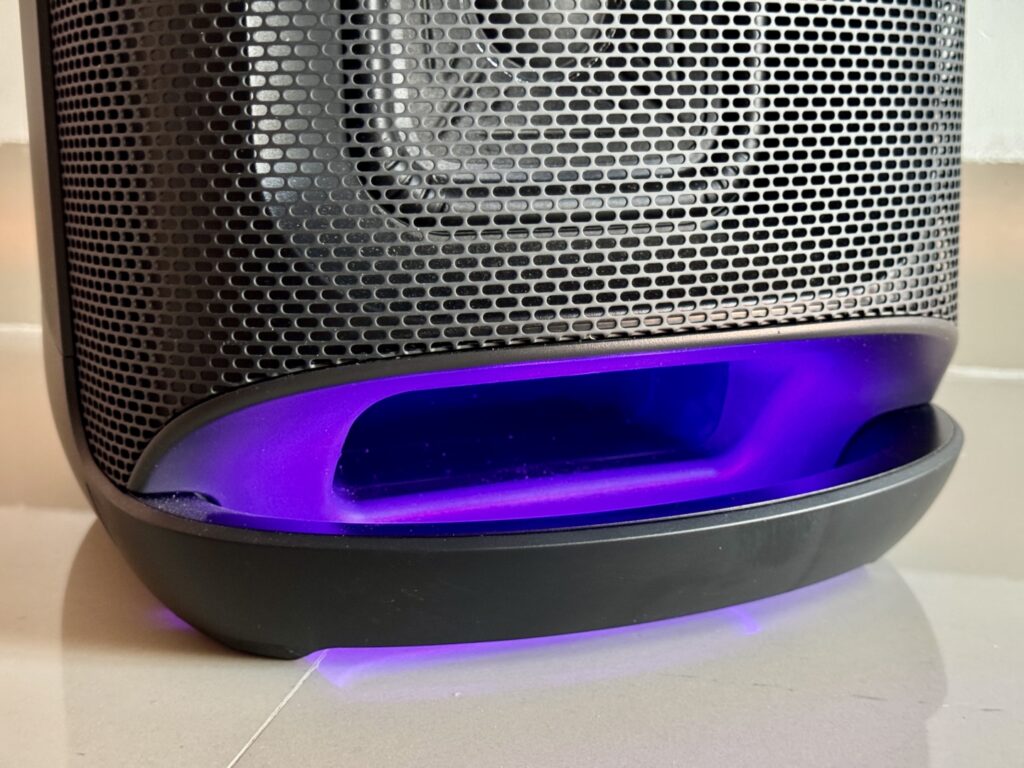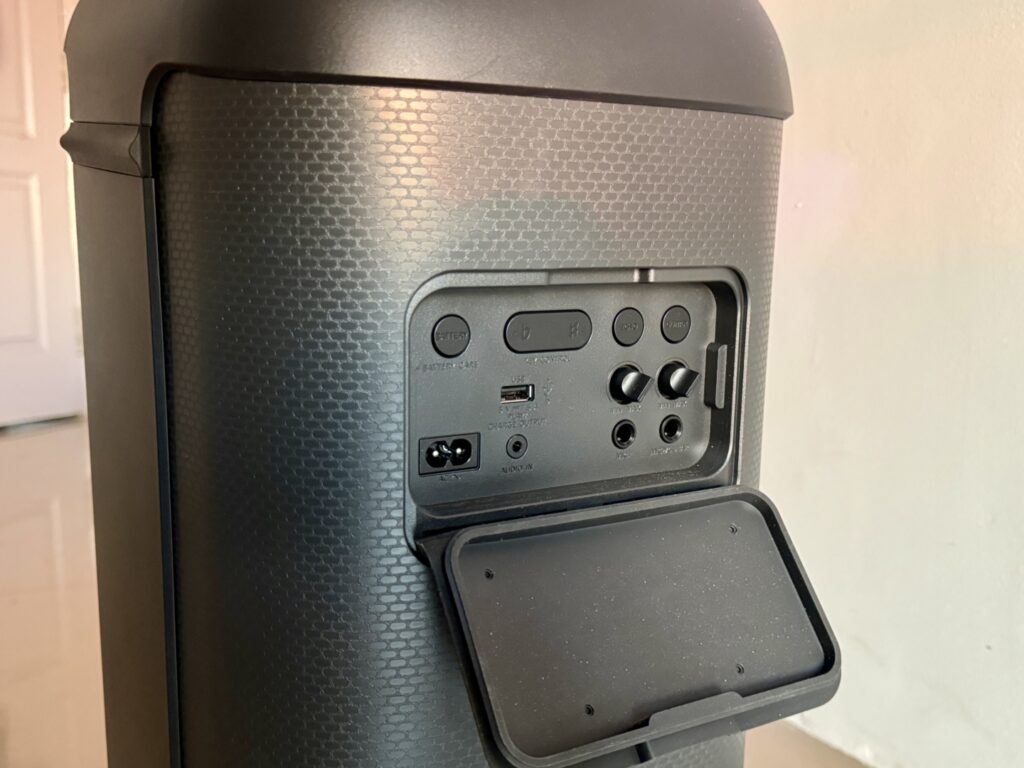Sony has been revamping its box speaker lineup with the new XV family speakers lately. Initially, we saw the Sony XV900, a personal favourite of mine due to its hefty size, powerful battery operation, and feature-packed and eye-catching floor lights. Following that, the Sony XV800 was also impressive for those who need something more affordable.
Now, entering the scene as the smallest member of this family is the Sony SRS-XV500, boasting refined upgrades over the Sony XP500. Priced at ₹31,999 retail, it aligns with the average for speakers of this size, and I anticipate Sony to offer occasional deals on these, considering their track record.
The company released its latest party speaker, SRS-XV500, last month in the U.S. and last week in India. It claimed to revolutionize your party scene, promising powerful sound, long battery life, and some nifty features. I have been using this speaker for around 15 days and tested these assertions, looking into whether it truly delivers on its pledges and justifies its price tag.

Can it genuinely produce the advertised deep bass without distortion? Is the battery life as enduring as claimed? Do the karaoke and guitar inputs truly enhance the entertainment value? To find those answers, let’s dive into the review and find out whether the SRS-XV500 is the ultimate party companion or just another overhyped gadget.
| Pros | Cons |
|---|---|
| Solid design, looks good | No wheels to drag |
| Great for outdoors | No remote control |
| Good audio performance | Audio E.Q. customization options are limited |
| Ample input options |
Design and build quality
Let’s look at the design of the XV500 speaker. It’s a tad smaller and curvier than its sibling, the XP500, which, in my book, is a nice touch. Up top, the control buttons have gone all fancy with capacitive tech, plus they light up – super handy for those late-night jam sessions. But other than that, the XV500 is pretty much like the XP500. Both are easy to lug around, weighing in at about 11.2kg. They’re IPX4-rated, so a bit of water won’t faze them, but they’re mostly plastic, so scratches and scuffs might be a thing, especially if you take it outdoors – given its wireless ability. And hey, no speaker stand mount, which is a bummer.

It comes in black, so that leaves you with limited choice on whether it goes with your room’s aesthetics—but I don’t see this as a problem since it will usually sit in the corner of the room. Also, I like the fact that there are rubber legs on the right side of the speaker, so you can lay it down horizontally if that suits your needs better.

Those lights are similar to the XP500, with a sleek light bar up top. You can tweak the modes through Sony’s app, but you’ll need the Fiestable app for color customization. The light show’s decent but not as flashy as some other speakers. Oh, and heads up – using the lights means sucking up more juice from the battery.
Battery life
When it comes to battery life, the XV500 steps it up from its older sibling, the XP 500. While the XP 500 claims 20 hours of playtime, the XV500 bumps it to 25 hours – a solid 5-hour upgrade. But here’s the catch: that 25-hour mark is when you’re playing it at 36% volume, lights off, but with the Mega Bass cranked up. Not precisely party mode, right? If you flip on the lights, your battery life dips to 12 hours. In real-life scenarios, blasting tunes at 80% volume with all the bells and whistles gets you around 8 to 9 hours of playtime. Crank it to max volume with all the extras, and Sony says you’ll get about 4.5 hours.

Unfortunately, as I live in an apartment, I couldn’t put that to the test. If you’re desperate to stretch that battery life, there’s Stamina mode, but it does flatten out the sound by turning off the lights and Mega Bass.
Connectivity
The XV500 offers the convenience of connecting two devices simultaneously, perfect for sharing DJ duties with a friend. Plus, latency isn’t an issue, making it ideal for watching videos on your phone without any lag. It ensures compatibility with various devices by supporting SBC, AAC, and LDAC audio codecs. However, LDAC support is limited to Android users, and utilizing LDAC may drain the battery faster. Moving on to ports, the XV500 features the standard 3.5mm audio jack but lacks an audio out jack and an optical port like its counterparts, limiting its versatility as a TV soundbar.

Nonetheless, it retains a USB-A port for charging or music playback from a USB stick. While this port may see more use in international markets, its utility in the U.S. might be limited due to the prevalence of USB-C charging cables. Additionally, the XV500 sports two 1/4-inch inputs for karaoke with two microphones or guitar input, adding more use cases for users. All of that works seamlessly on this.
How is the karaoke and guitar input?
The control panel on the top of the XV500 comes in use when you plug in accessories like a microphone or guitar. You’ve got some neat features up there. First, you can add an echo to your microphone, but don’t worry; it won’t mess with your music. There’s also a key function where you can tweak the key of your music. The key function alters the pitch of your tunes without affecting your voice. You can also make it sound deeper if that’s more your vibe. And that’s it for the control panel on the back.
To sum it up, you can play around with echo for your mic or tweak the key of your music, but you need to keep the microphone’s EQ itself. Overall, if you’re into karaoke, the XV500 is a solid choice, especially since you can plug in two microphones. But in terms of sound customization, it’s limited. Who needs an echo on their mic? And the whole key change thing needs to be more practical in my book.
How is the audio?
The Sony SRS-XV500 packs some neat tweaks compared to the XP500. With dual front-firing woofers and slightly larger tweeters, the XV500 promises a rich sound experience. Plus, its forward-facing exhaust port ensures the sound is directed right where you want it – towards you. But here’s the deal with volume: running it on its internal battery might feel a tad quieter than some other box speakers out there. You might find yourself cranking up the volume a bit more than usual. And at max volume on battery power, it may not blast as loud as you’d expect. But here’s the kicker – plug it in, and bam! You get a serious performance boost. It pumps out a louder sound and a deeper bass. The difference between battery and plugged-in mode is huge, way more than you’d see in other speakers.

So, let’s get to the sound test. I cranked up the speaker up to 75% volume, tested, plugged in, and unplugged. Oh, and I toggled off the Mega Bass feature. And guess what? There’s a big difference in sound quality between the battery and plugged-in mode for the XV500. Sure, running it unplugged might mean jacking up the volume a bit, but when it’s plugged in, it’s like a whole new beast. If you’re throwing a party with this thing, my advice? Keep it plugged in for max oomph.
Regarding sound quality, the XV500 brings a more balanced vibe than its predecessors. Thanks to those larger tweeters, it’s got better instrument separation and a wider soundstage. And those highs? They’re crisper and more detailed. Plus, you can always mess with the EQ to get that perfect sound if you’re into tweaking. But the stock EQ does a pretty solid job. So yeah, when it comes to sound, the XV500 holds its own.
A nifty feature – for parties
One of the less-used but super-useful features on Sony’s most Bluetooth speakers is Party Connect. You can link it with other Sony Party Connect speakers like the XV900, XV800, XP700, or XP500. You can connect up to 100 speakers, as per the company. Using the Sony app, you can pair it with smaller, portable speakers like the XG500, XE300, or XB43. While pairing three speakers usually works smoothly, issues may arise with more than four speakers, requiring multiple attempts. Overall, Party Connect offers a convenient way to customize your audio setup.
Should you buy it?
So, wrapping it all up, the Sony XV500 is like the XP500’s cooler cousin. What’s cool about it? Well, it sounds way better, with a more balanced vibe and a wider soundstage that opens up your tunes. Looks-wise, it’s got a rounder shape, which I dig, plus those top buttons light up now, adding a nice touch and practicality.
But here’s the thing – it still shares that volume quirk with the XP500. It might feel a bit quiet on battery power, but plug it in, and it kicks into gear just like you’d expect. Also, I don’t know why there’s no remote control bundled with these speakers – which can make controlling it so much easier. So yeah, overall, it’s a solid upgrade if you’re after better sound quality and some slick design improvements.
Photos By – Sudhanshu Singh/Benzinga
© 2025 Benzinga.com. Benzinga does not provide investment advice. All rights reserved.